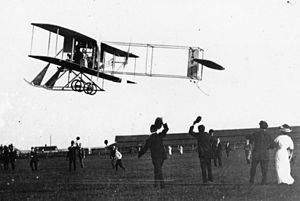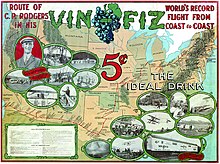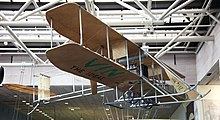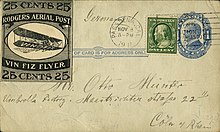
The Wright brothers, Orville Wright and Wilbur Wright, were American aviation pioneers generally credited with inventing, building, and flying the world's first successful motor-operated airplane. They made the first controlled, sustained flight of a powered, heavier-than-air aircraft with the Wright Flyer on December 17, 1903, 4 mi (6 km) south of Kitty Hawk, North Carolina, at what is now known as Kill Devil Hills. The brothers were also the first to invent aircraft controls that made fixed-wing powered flight possible.

The Inverted Jenny is a 24 cent United States postage stamp first issued on May 10, 1918, in which the image of the Curtiss JN-4 airplane in the center of the design is printed upside-down; it is one of the most famous errors in American philately. Only one pane of 100 of the invert stamps was ever found, making this error one of the most prized in philately.

Postal history is the study of postal systems and how they operate and, or, the study of the use of postage stamps and covers and associated postal artifacts illustrating historical episodes in the development of postal systems. The term is attributed to Robson Lowe, a professional philatelist, stamp dealer and stamp auctioneer, who made the first organised study of the subject in the 1930s and described philatelists as "students of science", but postal historians as "students of humanity". More precisely, philatelists describe postal history as the study of rates, routes, markings, and means.

An airmail stamp is a postage stamp intended to pay either an airmail fee that is charged in addition to the surface rate, or the full airmail rate, for an item of mail to be transported by air.
This is a list of aviation-related events from 1911:

John Rodgers was an officer in the United States Navy and a pioneering aviator.

Peter M. Bowers was an aeronautical engineer, airplane designer, and a journalist and historian specializing in the field of aviation.
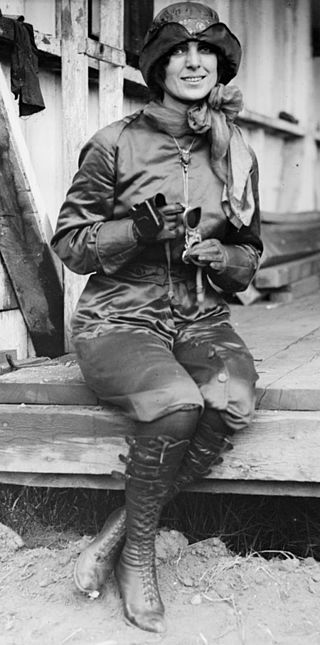
Harriet Quimby was an American pioneering aviator, journalist, and film screenwriter.

The Wright Flyer made the first sustained flight by a manned heavier-than-air powered and controlled aircraft—an airplane—on December 17, 1903. Invented and flown by brothers Orville and Wilbur Wright, it marked the beginning of the pioneer era of aviation.
The Wright Flyer III was the third powered aircraft by the Wright Brothers, built during the winter of 1904–05. Orville Wright made the first flight with it on June 23, 1905. The Flyer III had an airframe of spruce construction with a wing camber of 1-in-20 as used in 1903, rather than the less effective 1-in-25 used in 1904. The new machine was equipped with the engine and other hardware from the scrapped Flyer II and, after major modifications, achieved much greater performance than Flyers I and II.

Eddie August Henry Schneider was an American aviator who set three transcontinental airspeed records for pilots under the age of twenty-one in 1930. His plane was a Cessna Model AW with a Warner-Scarab engine, one of only 48 built, that he called "The Kangaroo". He set the east-to-west, then the west-to-east, and the combined round trip record. He was the youngest certificated pilot in the United States, and the youngest certified airplane mechanic. He was a pilot in the Spanish Civil War in the Yankee Squadron. He died in an airplane crash in 1940, while training another pilot, when a Boeing-Stearman Model 75 belonging to the United States Navy Reserve overtook him and clipped his plane's tail at Floyd Bennett Field.
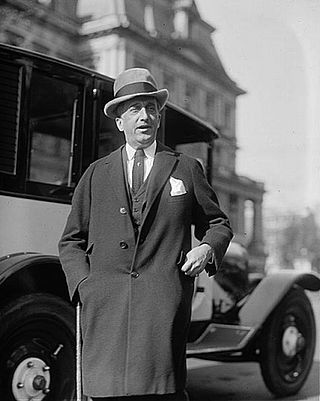
Jonathan Ogden Armour was an American meatpacking magnate and only surviving son of Civil War–era industrialist Philip Danforth Armour. He became owner and president of Armour & Company upon the death of his father in 1901. During his tenure as president, Armour and Co. expanded nationwide and overseas, growing from a mid-sized regional meatpacker to the largest food products company in the United States.

Calbraith Perry Rodgers was an American aviation pioneer. He made the first transcontinental airplane flight across the U.S. from September 17, 1911, to November 5, 1911, with dozens of stops, both intentional and accidental. The feat made him a national celebrity, but he was killed in a crash a few months later at an exhibition in California.

The Wright Model A was an early aircraft produced by the Wright Brothers in the United States beginning in 1906. It was a development of their Flyer III airplane of 1905. The Wrights built about seven Model As in their bicycle shop during the period 1906–1907, in which they did no flying. One of these was shipped to Le Havre in 1907 in order to demonstrate it to the French. The Model A had a 35-horsepower (26 kW) engine and seating for two with a new control arrangement. Otherwise, it was identical to the 1905 airplane. The Model A was the first aircraft that they offered for sale, and the first aircraft design to enter serial production anywhere in the world. Apart from the seven machines the Wrights built themselves in 1906–1907, they sold licences for production in Europe with the largest number of Model A's actually being produced in Germany by Flugmaschine Wright GmbH, which built about 60 examples.
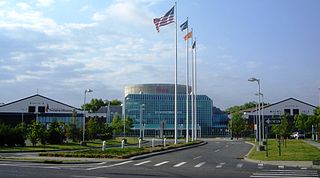
The Cradle of Aviation Museum is an aerospace museum located in Uniondale, New York on Long Island, established to commemorate Long Island's part in the history of aviation. It is located on land once part of Mitchel Air Force Base which, together with nearby Roosevelt Field and other airfields on the Hempstead Plains, was the site of many historic flights. So many seminal flights had occurred in the area that, by the mid-1920s, the cluster of airfields was already dubbed the "Cradle of Aviation", the origin of the museum's name.

Brackett Field is a public airport a mile (2 km) southwest of La Verne, in Los Angeles County, California, United States. It was named after astronomer Frank Parkhurst Brackett (1865–1951).
A transcontinental flight is a non-stop passenger flight from one side of a continent to the other. The term usually refers to flights across the United States, between the East and West Coasts.

The Wright Flying School, also known as the Wright School of Aviation, was operated by the Wright Company from 1910 to 1916 and trained 119 individuals to fly Wright airplanes.

Alys McKey Bryant was an American aviator. She was the first woman to fly on the Pacific Coast and in Canada, and one of the few female members of the Early Birds of Aviation—individuals who had solo piloted an aircraft prior to December 17, 1916. She set an altitude record for women, and trained pilots during World War I.

The Perry family is an American naval and political dynasty from Rhode Island whose members have included several United States naval commanders, naval aviators, politicians, artists, clergymen, lawyers, physicians, and socialites. Progeny of a mid-17th-century English immigrant to South Kingstown, Rhode Island, the Perry family patriarch, Captain Christopher Raymond Perry, and his two sons Commodore Oliver Hazard Perry and Commodore Matthew C. Perry, were seminal figures in the legitimization of the United States Navy and establishment of the United States Naval Academy.
